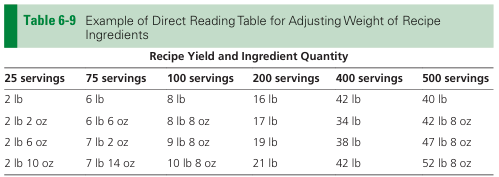Chapter 6: Food production (subsystem, decisions, forecasting, planning, ingredient control, recipe, adjustment methods)
1/79
There's no tags or description
Looks like no tags are added yet.
Name | Mastery | Learn | Test | Matching | Spaced |
|---|
No study sessions yet.
80 Terms
what is the objective of food production
the preparation of menu items in the needed quantity and with the desired quality, at a cost appropriate to the particular foodservice operation
define food production
Preparation of menu items in the needed quantity and the desired quality at a cost appropriate to the particular operation
define production
Preparation of menu items in the needed quantity and the desired quality at a cost appropriate to the particular operation
PLANNING FOR PRODUCTION
define planning for production
Establishment of program of action for transformation of resources into products and services
where does production fall in the foodservice graph
transformation
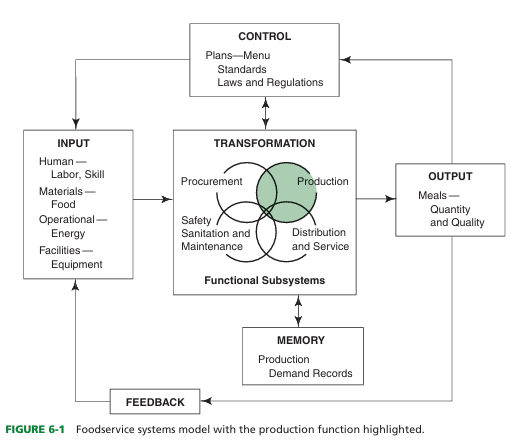
how often are decisions made
daily
about necessary quantities to produce and the quality that must be maintained within cost limitations
define elements of decision making
forecasting, planning, and production scheduling
production planning primarily is the effective synthesis of what 3 things
quantity, quality, and cost objectives
what are the secondary objectives for production decisions (4)
product/service characteristics
process characteristics (how food is processed, cooked)
product/service quality
efficiency (depends on labor, material and facility cost)
customer service
why is maintenance of quality a cost factor
because of employee training, inventory control of both raw and prepared food items, and sanitation programs
cost element in planning is result of the correlation of what 4 things
food
storage
issue
production costs with labor, facility, and energy costs
FORECASTING
define forecasting
Art and science of estimating events in the future, which provides a database for decision making and planning
foodservice managers are concerned with what (why we do forecasting)
food cost
define overproduction and its effects
Production of more food than is needed for service.
-generate extra costs due to food waste, extra labor costs
define underproduction and its effects
Production of less food than is needed for service
-increase cost AS MUCH as overproduction because disappoints customer, additional labor cost, and substitutions (recompensas) can be expensive
when it comes to forecasting, production managers should know estimated number of what
customers and servings of each menu item
how do adequate historical records aid the forecasting process
can be used to see past customer counts, number of meals, menu items, or sales records
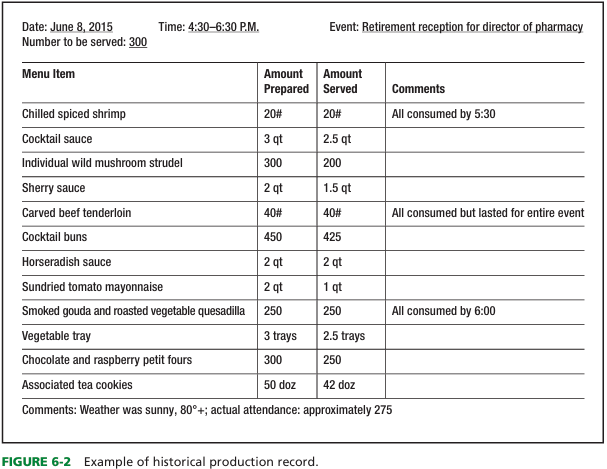
what should historical record include
Date and day of the week
Meal or hour of service
Notation of special event, holiday, and weather conditions, if applicable
Food items prepared
Quantity of each item prepared
Quantity of each item served
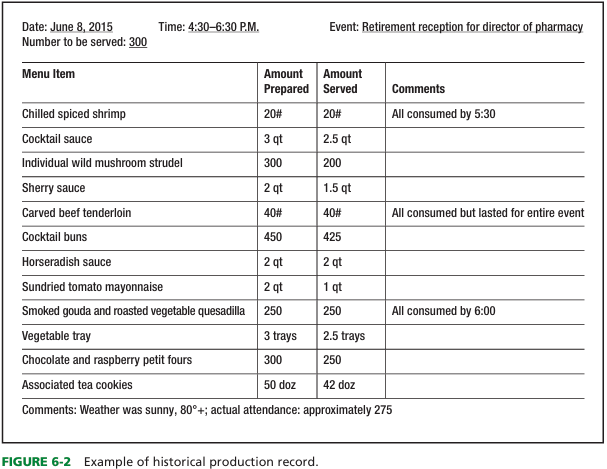
how is forecasting done??
usually models are used
what is the criteria for forecasting models (5)
Cost
Required accuracy
Relevancy of past data
Forecasting lead time- Lead time pertains to the length of time into the future that the forecasts are made
Underlying pattern of behavior
what are the 3 types of common forecasting models
time series
causal
subjective
explain the time series model
based on the assumption that actual occurrences follow an identificable pattern over time
when do time series models work the best
for short term forecast
what are the 2 main types of time series models
moving average AND exponential smoothing
Define/explain moving average forecasting model
Time series model that uses a repetitive process for developing a trend line by averaging the number of servings for a specified number of times for the first point on the line and then dropping the oldest and adding the newest number of servings for subsequent points.

define/explain exponential smoothing forecasting model
Time series model in which an exponentially decreasing set of weights is used, giving recent values more weight than older ones
very similar to the moving average model except that it does not uniformly weigh past observations

explain causal model
similar to time series in sense that it assumes an identifiable relationship between item of forecast and other factors BUT is MORE COMPLEX as it takes in more factors
best for medium to long term forecast (like canned goods)
define/explain regression analysis forecasting models
Causal models that are based on the assumption that the linear relationship between variables will continue for a reasonable period of time.
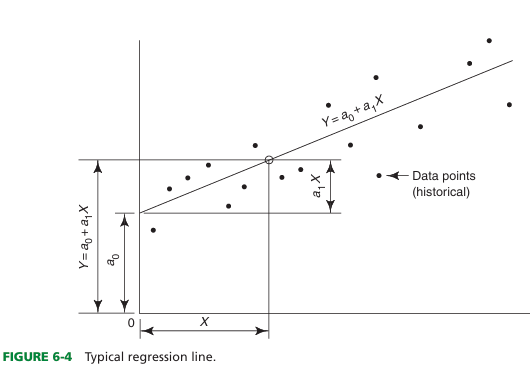
define linear
signifies the intent of the analysis to find an equation for a straight line that fits the data points most closely
define dependent variable
the item being forecast
define Independent variable
the factors that affect it
explain subjective model (specially when it is used)
A subjective forecasting model generally is used when relevant data are scarce or patterns and relationships between data do not tend to persist over time
Forecasters must rely on opinions and other information, generally qualitative, that might relate to the item being forecast
define the Delphi technique
Panel of experts who individually complete questionnaires on a chosen topic until a consensus is reached
PRODUCTION SCHEDULING
define production scheduling
Time sequencing of events required by the production subsystem to produce a meal.
for foodservice, what types of recipes should be used
standardized recipes
what are the 2 stages of scheduling
planning and action w
what is planning stage
forecasts are converted into the quantity of each menu item to be prepared and the distribution of food products to supervisors in each work center
what is action stage
preparing a production schedule
define production schedule
Written plan for production for a specific date and/or mea
what is a major control in the production subsystem
production schedule because it activates the menu and provides a test of forecasting accuracy
what must be included in the production menu (6)
The unit
Production date
Meal
Actual customer count
Weather
Special events

what in production schedule must be included to make specific action plan (10)
Employee assignments
Prep time schedule
Menu item
Over-and underproduction
Quantity to prepare
Substitutions
Actual yield
Additional assignments
Special instructions and comments
Preparation
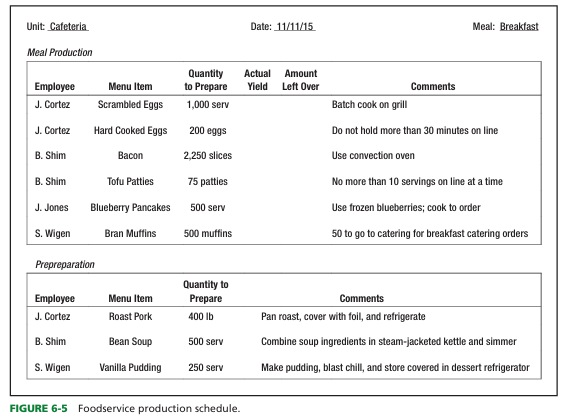
define batch cooking
Cooking smaller quantities of menu items as needed for service
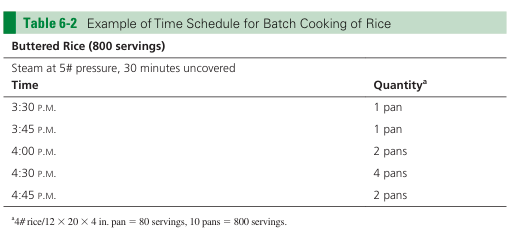
INGREDIENT CONTROL
what is a major component of quality and quantity control in the production subsystem and a critical dimension of cost control throughout the foodservice system
ingredient control
how does process of ingredient begin and continues to what
the process of ingredient control begins with purchasing, receiving, and storage of foods and continues through forecasting and production
what are the 2 main aspects of ingredient control (2 main methods to control it)
Ingredient assembly
Use of standardized recipes
define ingredient room
ingredient assembly area designed for measuring ingredients to be transmitted to the various work centers.
define standardized recipe
Recipe that consistently delivers the same quantity and quality of a product when followed precisely
what components are important aspects of ingredient control (think chpt 5)
receiving, storage, and inventory control
advantages of using centralized assembly area (ingredient room)
The ingredient room contributes to cost reduction and quality improvement by stopping production employees from withdrawing large quantities of products from storage whether or not they are needed
can help eliminate over and underproduction
how does centralized ingredient control work (in terms for the cook)
the cook is issued only what is needed for the forecast production demands on the day of service - the excess is held in frozen storage in the ingredient room until the next time the ingredients are needed for a recipe
in centralized ingredient control how is control of unused portions facilitated
because storage is located centrally rather than in various work units throughout the kitchen.
what is the primary function of the ingredient room
to coordinate assembly, prepreparation, measuring, and weighing of the ingredients to meet both the daily production needs and the advance preparation needs of recipes for future meals
what should be in ingredient room (like organization)
fridge, water supply, carts, portable bins, worktable/counter, and scales
scales are MOST ESSENTIAL
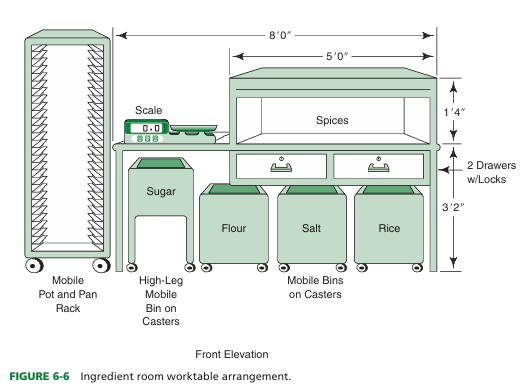
what is the most essential piece of equipment in ingredient room
Scales
who should be in ingredient room
authorized personnel that are assigned to room and trained
RECIPES
define recipe
Formula by which weighed and measured ingredients are combined in a specific procedure to meet predetermined standards
when is a recipe considered standardized
Once a recipe has been tested repeatedly to give same results and accepted by management and customers
format of recipes
for foodservice usually in BLOCK FORMAT
includes:
Name of item
Total yield
Portion size and # of portion
Cooking time and temp
List of ingredients in order of use
Amount of each ingredient by weight, measure, or count
Procedures
Plating info
Serving and garnishing suggestions
HACCP guidelines
Can also include nutrition info
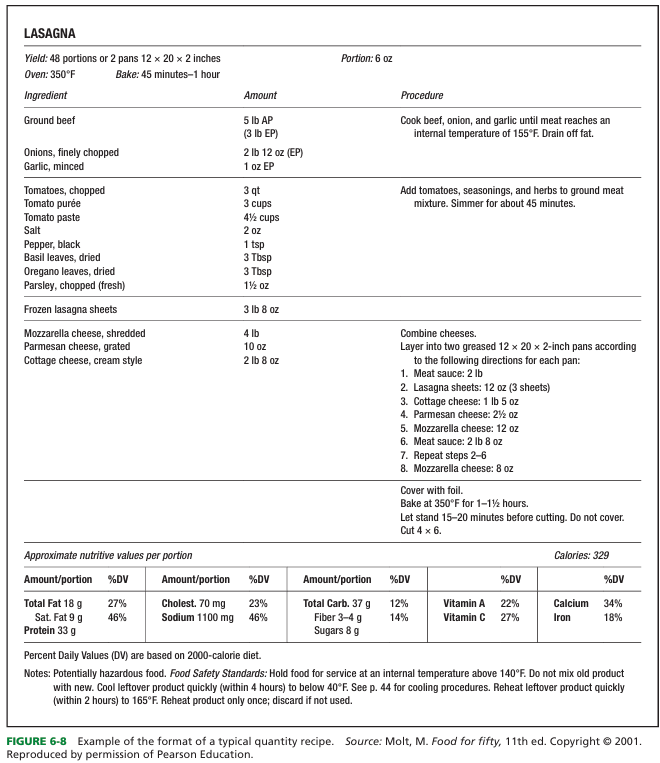
define recipe standardization
Process of tailoring a recipe to suit a particular purpose in a specific foodservice operation
define quantity recipe
Recipe that produces 25 or more servings
are quantity recipes standardized recipes?
No, until they have been adapted to individual operation
advantages to recipe standardization (11)
Promote uniform quality of menu items
Promote uniform quantity of menu items.
Encourage uniformity of menu items.
Increase productivity of cooks.
Increase managerial productivity.
Save money by controlling overproduction.
Save money by controlling inventory levels
Simplify menu item costing.
Simplify training of cooks.
Introduce a feeling of job satisfaction
Reduce anxiety of customers with special dietary needs.
what is recipe verification
4 step process of:
reviewing components of recipe
make recipe
verify the yield
record changes on recipe
what is product evaluation
evaluation the result of the recipe
when does product evaluation occur
after recipe verification
what does product evaluation help with
determine the acceptability of the recipe by foodservice managers and staff and customers
define informal evaluation
General assessment of product or ser vice; no evaluation form or procedure used
Typically completed when the product is first prepared
define formal evaluation
Detailed assessment of product or service; evaluation form used and detailed evaluation procedure followed.
If foodservice staff members believe a recipe has potential for use in the operation, then a formal evaluation is conducted
QUANTITY ASSESSMENT
what are the 3 procedures that have been developed for quantity adjustment of recipe
factor method
percentage method
direct reading measurement table
what is the factor method (steps)
STEP 1 Convert all ingredients from measure to weight in pounds and ounces. Whenever possible, state liquid measures in weights; however, liquid measurements may be converted to decimal equivalents of a quart or gallon.
STEP 2 Convert ingredient quantity to whole numbers and decimal equivalents and round to one decimal place unless the original amount is less than one pound; that is, 2 lb 10 oz would be converted to 2.625 lb, but rounded to 2.6 lb for use. For amounts less than one pound, two places would be shown (e.g., 0.62 lb). Table 6-3 provides data for convert ing ounces into decimals of a pound and cups and quarts into decimal parts of a gallon.
STEP 3 Divide the desired yield by the base recipe yield to determine the conversion factor.
STEP 4 Multiply all recipe ingredients by the conversion factor.
STEP 5 Reconvert the new ingredient quantities back into pounds and ounces or quarts and cups.
STEP 6 Round off amounts to quantities simple to weigh or measure and within an acceptable margin of error
what is percentage method
measurements for ingredients are converted to weights and then the percentage of the total weight for each ingredient is computed
steps of percentage method (8)
STEP 1 Convert all ingredients from measure or pounds and ounces to tenths of a pound. Make desired equivalent ingredient substitutions, such as frozen whole eggs for fresh or powdered milk for liquid.
STEP 2 Total the weight of ingredients in a recipe after each ingredient has been converted to weight in the edible portion (EP). For example, the weight of carrots or celery should be the weight after cleaning and peeling. The recipe may show both AP (as purchased) and EP weights, but the edible portion is used in determining the total portion weight.
STEP 3 Calculate the percentage of each ingredient in the recipe in relation to the total weight. (Note: The sum of all percentages must equal 100.)
STEP 4 Check the ratio of ingredients. Standards of ingredient proportions have been established for many items. The ingredients should be in proper balance before going further.
STEP 5 Establish the weight needed to provide the desired number of servings, which will be in relation to pan size, portion weight, or equipment capacity.
STEP 6 Handling loss must be added to the weight needed and may vary from 1 to 10%, depending on the product. Similar items produce predictable losses that with some experimentation can be accurately assigned.)
STEP 7 Multiply each ingredient percentage number by the total weight to give the exact amount of each ingredient needed. After the percentages of each ingredient have been established, any number of servings can be calculated and the ratio of ingredients to the total will be the same. As in the factor method, one decimal place on a recipe is shown unless the quantity is less than 1 pound, in which case two places are shown.
STEP 8 Unless scales are calibrated to read in pounds and tenths of a pound, convert to pounds and ounces or to measure.
what is direct reading measurement tables
The third method of recipe adjustment uses direct reading measurement tables.
These tables have the advantage of being simple and quick to use and require no mathematical calculations.
he third method of recipe adjustment uses direct reading measurement tables.
These tables have the advantage of being simple and quick to use and require no mathematical calculations.
